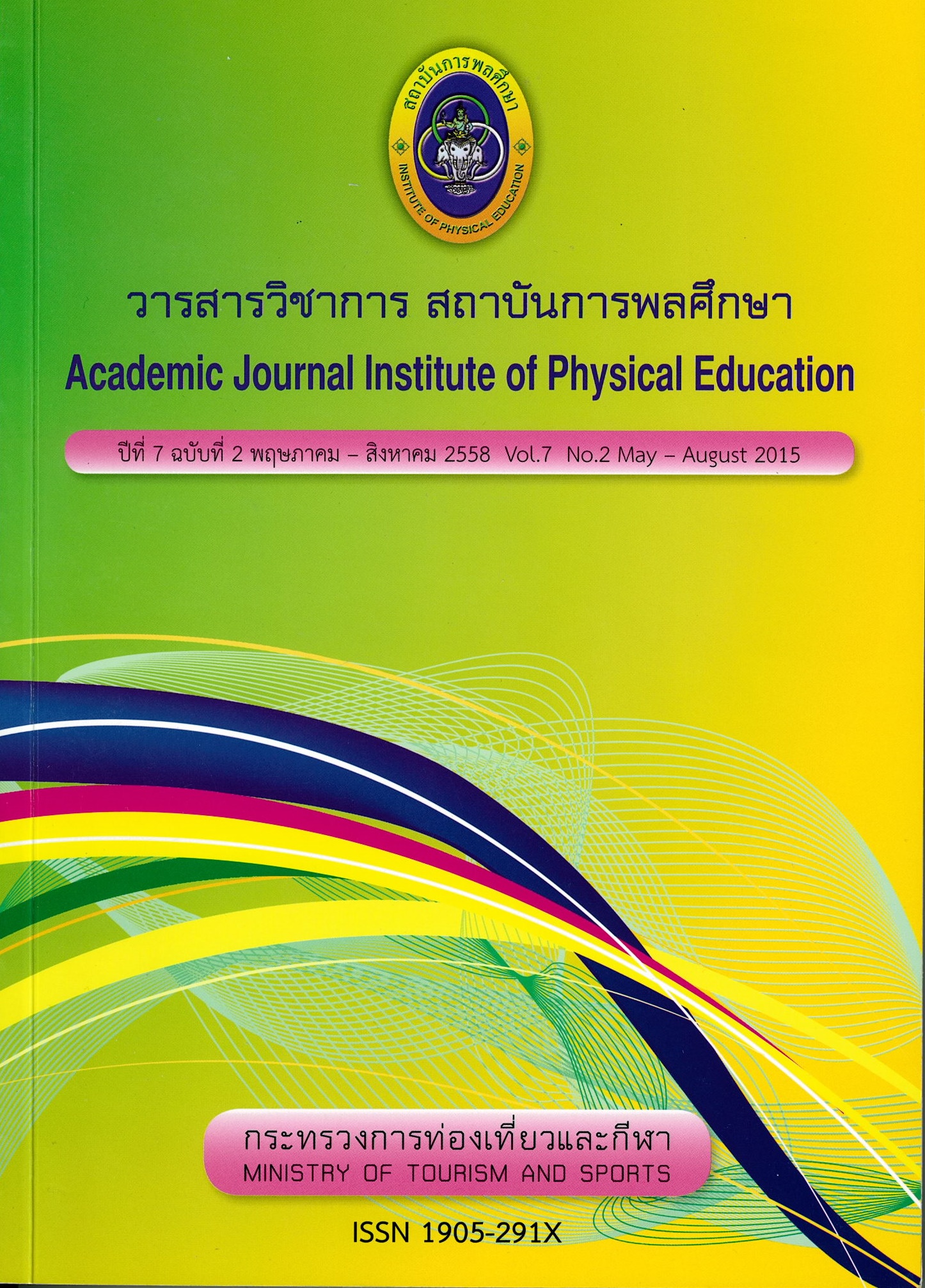Organizing Morality and Ethics Promoting Activity for Students for the Purpose of Developing the Human Resource
Main Article Content
Abstract
The Purposes of this study were: 1) to study morality and ethics which should be promoted among the students of Institute of Physical Education, 2) study the activities which will help promote the morality and ethics of students of Institute of Physical Education, 3) to create and supervise the form of activities which will help promote the morality and ethics of the students of Institute of Physical Education for the purpose of developing the human resources, and 4) to experiment and evaluate the form of activities which will help promote the morality and ethics of students of Institute of Physical Education for the purpose of developing the human resource. This research was a mixed method research which was mixed between a qualitative and quantitative research. The theory of human resource was used as the basis to conduct this research. The sample populations were comprised of: 1) the involved people who were the administrators of student affairs division or director of student activities division and the president of students' club, 2) the experts who were academicians, administrators of
various educational institutions, and the monks, and 3) the practitioners who were the students belonging to the faculty of liberal arts, Institute of Physical Education, Chonburi
campus.
The data collecting in this research was conducted through document study and content analysis, field study which includes interview and focus group, and action. The tool used in this research was semi-structured interview, close-ended questionnaire, open-ended questionnaire and self-evaluation form. The data collected was described through descriptive statistics which include percentage, arithmetic mean, standard deviation, inferential analytical statistics, t-test and ANOVA, Scheffe's method. For qualitative data, content analysis was applied.
The findings revealed that in promoting the human resources, there are four components which are as follows;
1) Two main principals
1.1) First principal is comprised of the following four elements: 1) Amusement, 2) Essence, 3) Calmness 4) Consciousness,
1.2) Second principal which is comprised of the following five elements: 1) To be a good daughter and son, 2) To be a good student, 3) To be a good companion, 4) To be a good religious youth 5) To be a good national youth.
2) Five activity forms for promoting the students' morality and ethics: 1) Chanting, 2) Meditation, 3) Listening to the sermon, 4) Rendering service to the monastery, 5) Entering the morality and ethics camp which was comprised of the following five bases; Base 1: Approaching the triple gems, Base 2: Thai youth far from using drugs, Base 3: Mind taming, Base 4: Good sons and daughters, and Base 5: Good students.
3) Procedures – Eight steps: Step 1) Selecting the points of morality and ethics to be focused on student development; Step 2) Understanding the points of morality and ethics which will be transmitted to the students in order to ensure the right understanding they will get; Step 3) Targeting the group of students who will participate in the project; Step 4) Setting the desirable objectives which will be beneficial for the students; Step 5) Considering the activities which should be conducted, determining the forms of activities which are suitable for the students and will attract the participation from the students; Step 6) Making action plan; Step 7) Considering the index of success for this project and Step 8) Performing according to the action plan.
4) Eight desirable qualities: 1) Diligence, 2) Being economic, 3) Integrity, 4) Discipline, 5) Politeness, 6) Cleanness, 7) Solidarity, 8) Sportsmanship.
Article Details

This work is licensed under a Creative Commons Attribution-NonCommercial-NoDerivatives 4.0 International License.
The published article is a copyright of the Academic Journal of Thailand National Sports University. The passage appeared in each article in this academic journal is a perspective of each author which is not related to the journal. Each author is required to be responsible for all components of his/her own article. If there are any mistakes, each author must be responsible for those mistakes on his/her own.
References
กรมวิชาการ. (2545). รายงานวิจัยเรื่องวัฒนธรรมสภาพแวดล้อมและค่านิยมที่เอื้อต่อการเรียนรู้ความดีและความสุขของผู้เรียน กรุงเทพฯ : โรงพิมพ์การศาสนา.
ฐาปนีย์ พสิษฐ์เนาวกุล. (2551). รายงานการวิจัยเรื่อง การศึกษารูปแบบการพัฒนาคุณธรรม จริยธรรม นักศึกษามหาวิทยาลัยราชภัฏเลย.
ดวงเดือน พันธุมนาวิน. (2540), ทฤษฎีต้นไม้จริยธรรม กรุงเทพฯ: โรงพิมพ์แห่งจุฬาลงกรณ์มหาวิทยาลัย.
ประคอง กรรณสูต. (2538), สถิติเพื่อการวิจัยทางพฤติกรรมศาสตร์, พิมพ์ครั้งที่ 2. กรุงเทพฯ: จุฬาลงกรณ์มหาวิทยาลัย.
พระณัฐวุฒิ คือทอ. (2552). รายงานการวิจัยเรื่อง การมีส่วนร่วมของพระสงฆ์ในการพัฒนาคุณธรรมจริยธรรมแก่นักเรียนในสถานศึกษาตําบลออนกลาง จังหวัดเชียงใหม่.
พระมหาบุญมี โททํา. (2551). รายงานการวิจัยเรื่อง บทบาทพระสงฆ์ต่อการพัฒนาคุณธรรม จริยธรรมของเยาวชน พระราชบัญญัติการศึกษาแห่งชาติ พ.ศ. 2542 และแก้ไขเพิ่มเติม (ฉบับที่ 2) พ.ศ. 2545. (2546). กรุงเทพฯ: องค์การรับส่งสินค้าและพัสดุภัณฑ์.
พระราชวรมุนี (ประยุทธ์ ปยุตโต), (2525), ธรรมนูญชีวิต. กรุงเทพฯ: อมรินทร์การพิมพ์.
มาลัยวัลย์ วงศ์ใหญ่; และคณะ. (2550). รายงานการวิจัยเรื่อง การพัฒนาคุณธรรม จริยธรรมพื้นฐาน 8 ประการของนักศึกษาวิทยาลัยอาชีวศึกษา.
สถาบันการพลศึกษา. (2548). หลักสูตรสถาบันการพลศึกษา ระดับปริญญาตรี พุทธศักราช 2548. กรุงเทพฯ : โรงพิมพ์องค์การรับส่งสินค้าและพัสดุภัณฑ์ (ร.ส.พ.)
สถาบันการพลศึกษา. (2553). ข้อมูลนักศึกษา, ชลบุรี: งานทะเบียนและวัดผล. สถาบันการพลศึกษา วิทยาเขตชลบุรี.
สํานักงานคณะกรรมการการอุดมศึกษา. (2552). กรอบมาตรฐานคุณวุฒิระดับอุดมศึกษาแห่งชาติ พ.ศ. 2552 และแนวทางการปฏิบัติ, กรุงเทพฯ: สํานักงานคณะกรรมการการอุดมศึกษา.
สุภางค์ จันทวานิช. (2540), การวิเคราะห์ข้อมูลในการวิจัยเชิงคุณภาพ. กรุงเทพฯ: จุฬาลงกรณ์มหาวิทยาลัย

